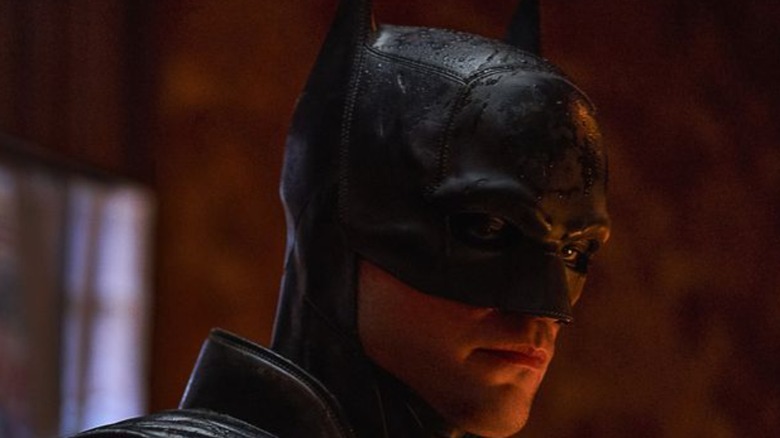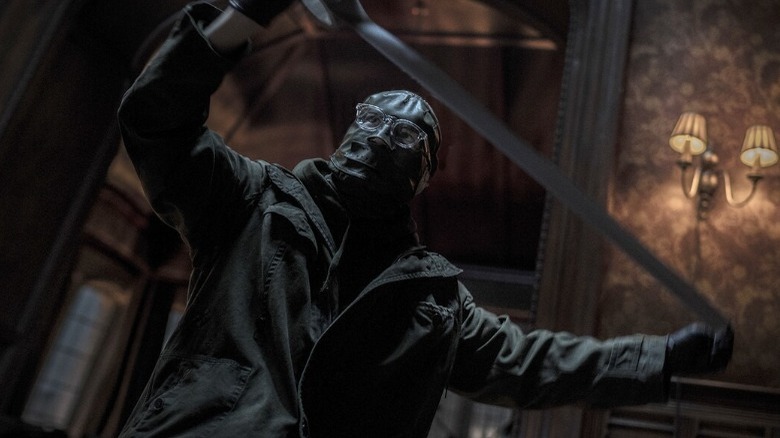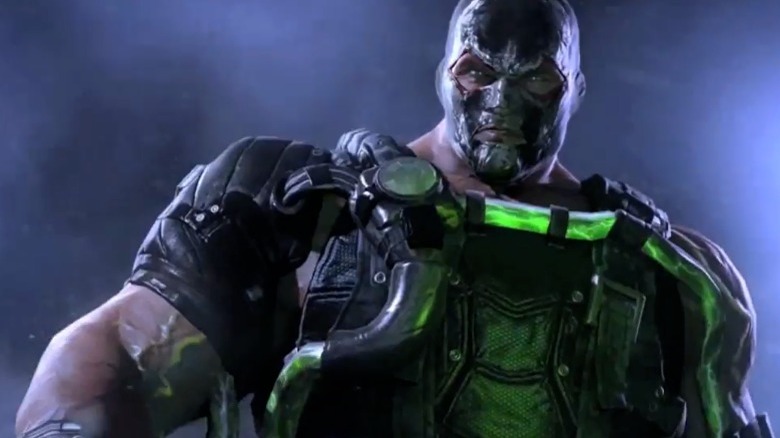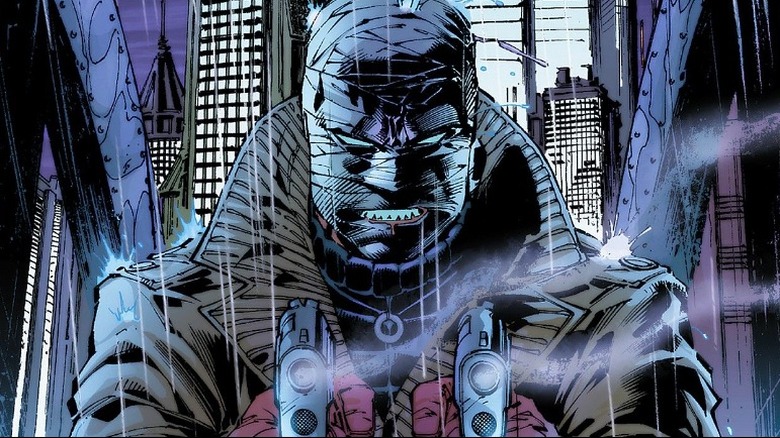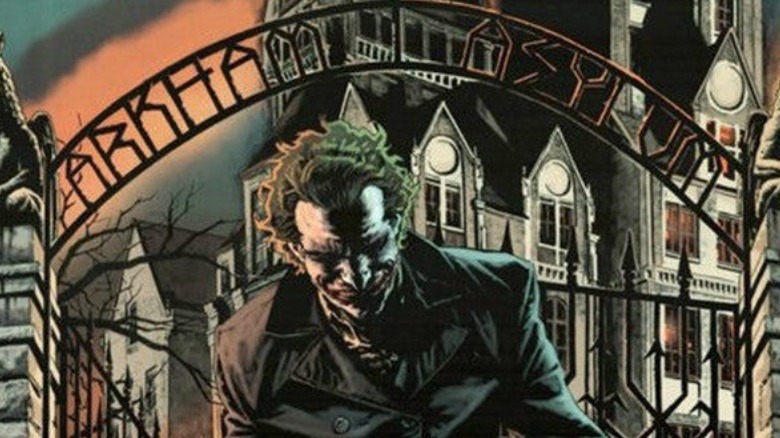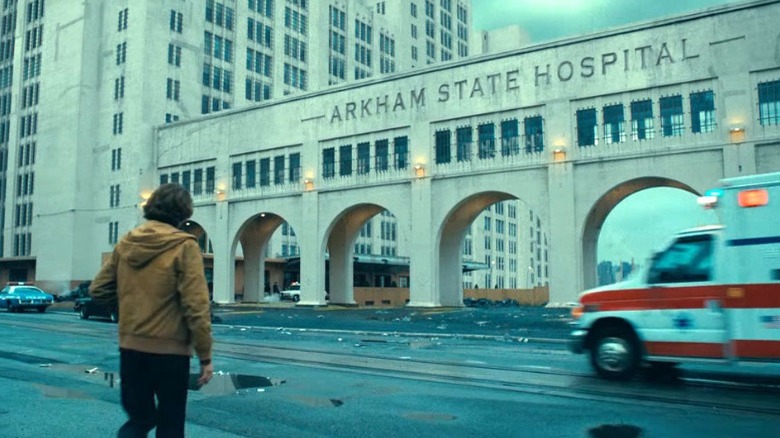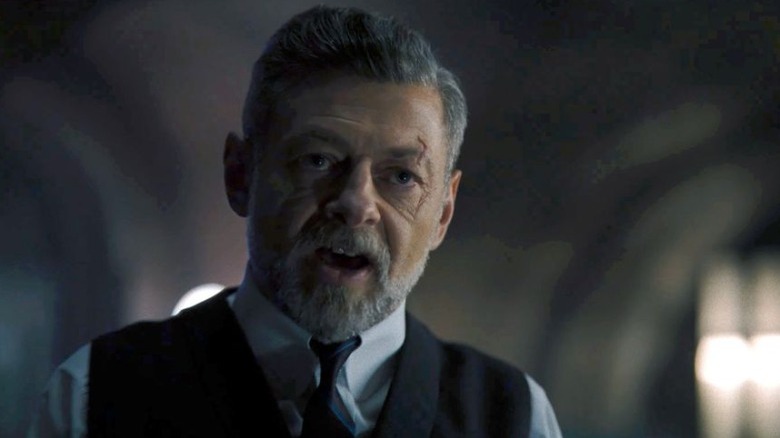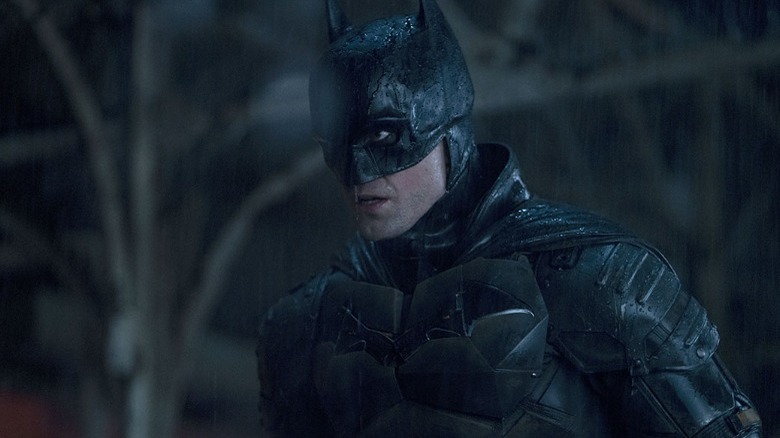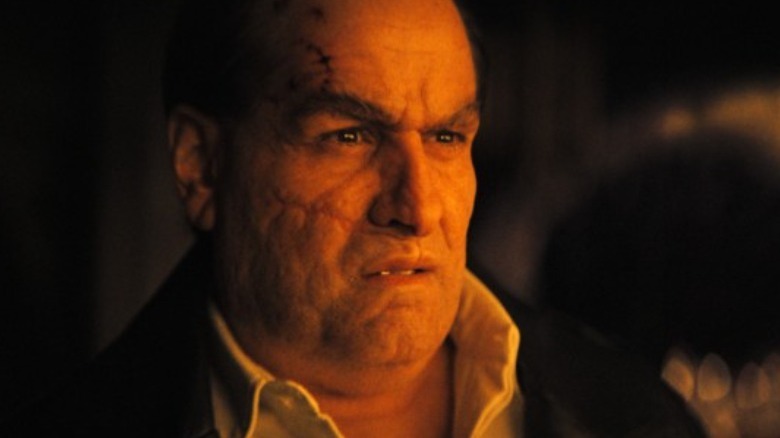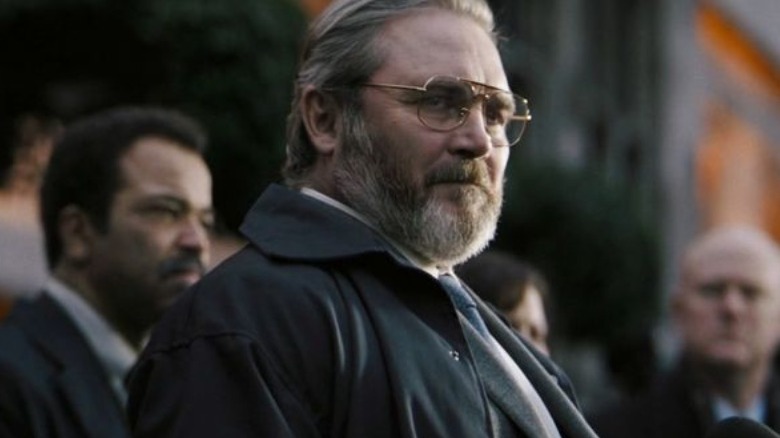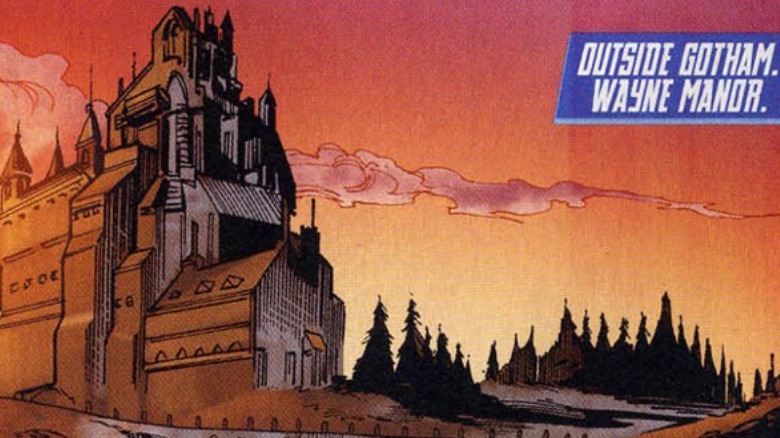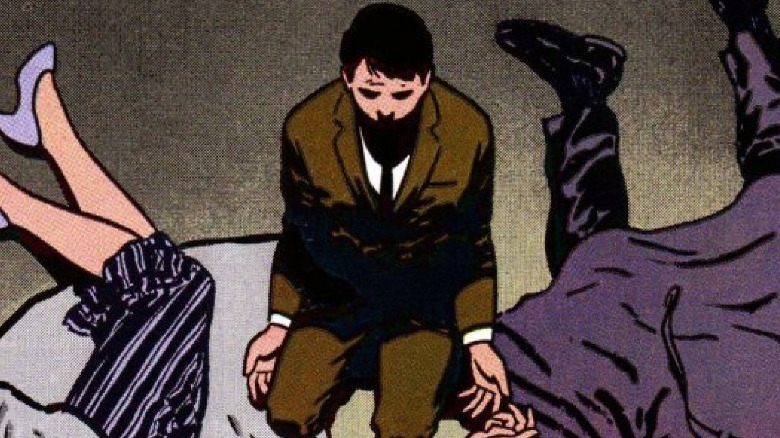The Biggest Unanswered Questions From The Batman
Warning: this article contains spoilers for "The Batman."
If the Batsignal doesn't give pause to the crooks and criminals of Gotham, hearing the thunderous roar of the vehicles Batman uses to cruise through town will surely do the trick. "The Batman" focuses on the vigilante in a way that previous films in the franchise never did. He's been operating on the streets for two years, and Batman's mission is already drenched in blood and broken bones. While he doesn't resort to killing, he's absolutely merciless when laying the pain on thick so criminals remember the trauma they endured at his hands. As a recluse, Bruce Wayne is sacrificing a life in the sun for the creature he becomes at night. Simply put, he's a broken man with a single agenda: vengeance.
But something miraculous happens throughout the perilous journey that the enigmatic Riddler takes him on. Batman, and Bruce by extension, begin to open up to the world and see that his crusade isn't simply about striking terror into the hearts of criminals. It's also about bringing hope to the good citizens of Gotham City. Selina Kyle enters Batman's life, forcing him to realize that there are real people on the ground suffering while he pursues his war on crime. It's an engaging tale, one rife with expert camera work, deliciously dense characters, and a narrative that focuses on Batman's own introspection as he grows from his newest experiences. While the film ends with the Riddler's far-reaching calamity sweeping the streets, the unity of the city and the call to rebuild offer a glimmer of hope for Gotham's future. Despite that resolution, there are many threads — some small and some large — that remain hanging in the balance. Let's take a look at the biggest unanswered questions in "The Batman."
Riddler's next door neighbor
Let's address the elephant in the room right off the Bat, shall we? Perhaps the biggest tease for Batman's future clash with villainy is the mysterious character sitting in the cell right next to the Riddler at the end of the film. He offers the Riddler friendship or an alliance in an effort to stage a "comeback" story for the people of Gotham.
At first glance, it seems like the figure might be Two-Face. His hair is unkempt and it appears that his face may be disfigured, at least on the one side that the audience is allowed to see. Furthermore, Batman fans will recognize that Carmine Falcone's operations were "busted" wide open by law enforcement prior to the events of the film. In Jeph Loeb's "The Long Halloween," it's Falcone's legal woes and his rivalry with Sal Maroni (which is also mentioned) that result in Harvey Dent being splashed with acid by a mobster during a testimony in court. This possibly could have already occurred prior to "The Batman," especially since Gil Colson is the D.A. and there is no mention of Harvey Dent. However, that cackle isn't necessarily something Two-Face is known for — in fact, it's far more reminiscent of the Joker. Furthermore, it appears that a Joker gang exists as Batman exacts bloody vengeance upon the crew in the opening moments of the film. Only time will tell.
Is Batman using Venom?
Fans know well that Batman prepares for just about any probable scenario. He often has access to a variety of tools or gadgets that he might need to rely on in a pinch in order to narrowly avert catastrophe. In the final moments of the film, Batman is fighting several of the Riddler's followers, who are all armed to the teeth. One particular baddie knocks the wind out of the Dark Knight with a rather close-range shotgun blast. Batman is visibly injured and likely suffering from fractured ribs. However, Selina Kyle enters the fray to save Batman and then takes heat from another goon. In an effort to save her, Batman pulls out a strange green fluid and injects himself with it, after which he quickly gets up and pummels his foe in a fit of rage.
Now what do we know about a green fluid that bolsters physical performance dramatically and might even cause someone to lose control of their anger? Bane might know the answer to this question, because in the comics, Venom is the name of a drug the back-breaking villain uses in an attempt to overpower Batman. The question "The Batman" viewers are left asking is: Was that vial filled with Venom? If so, why would Batman be carrying it? Perhaps he had it on hand as a last resort?
Could Hush be an upcoming villain?
The Riddler is very thorough when he goes combing through the history books of Gotham City in an attempt to eliminate every bit of corruption he can find by wiping out the politicians and law enforcement personnel who aren't living up to their oaths to serve the citizenry. The Riddler's mission becomes clear: kill a corrupt official, then destroy their reputation by outing their dirty deeds on the nightly news. During his vigilante crusade, he targets the Wayne family, and among his newspaper clippings is one that highlights a seeming partnership between Thomas Wayne and crime boss Carmine Falcone. In the stack, one headline can be seen referencing Edward Elliot.
The Riddler clearly has his eye on the Wayne and Arkham families who helped establish Gotham City. However, Edward Elliot was also a wealthy aristocrat who played a fundamental role in modernizing the city. In the comics, he's an ancestor of Thomas Elliot, who was Bruce Wayne's friend when they were kids. He later turned to a life of crime, adopting the moniker of Hush and using his talents and medical expertise to wage war against Bruce while finding ways to blame him for his awful childhood. Underneath it all, Thomas was envious of Bruce's life despite the tragedy that he suffered in Crime Alley as a young boy; this villain's nefarious deeds are ultimately very personal for Batman as a result. Now that we know the Elliot family exists within the Gotham City of "The Batman," there's always a chance that Hush could take center stage.
Is the Arkham family active?
The Riddler highlighted two of Gotham's most elite families: the Waynes and the Arkhams, two wealthy clans that helped establish the city. During the Riddler's crusade against the corrupt in Gotham, he discusses Thomas Wayne's culpability for working with the mob and associating with the likes of Carmine Falcone while vying for the mayoral position. Even though the Riddler brings up the two families, he really only focuses on the Waynes and their closeted collaboration with organized crime. The Arkham family is never discussed in great detail.
What we do know is that the greatest psychiatric facility for crazed super villains is none other than the famous Arkham Asylum in Batman comics lore. Is the Arkham family still active in Gotham? Or is the famous holding facility their only real claim to fame and their greatest addition to the city of Gotham? Clearly the Riddler didn't attack anyone within the Arkham family. That could be because their family line is no more, or because the living Arkham family members are squeaky clean. Perhaps Batman's next foe will teach us more about what happened to the Arkhams.
Why is Arkham a state hospital?
The Riddler made his capture rather easy. Clearly, he had an endgame in mind that the Gotham police department wasn't privy to — and neither was Batman, despite the Riddler's attempts to enlighten him. When we see the Riddler sitting safe and sound on the opposite side of hardened glass talking to Batman about his plan, viewers can see clearly that he has an "Arkham State Hospital" suit on. Why is the facility not referred to as Arkham Asylum? Will the State Hospital undergo changes after a new surge in high-profile villains begin making their way into police custody after being captured by Batman?
In the film "Joker," Joaquin Phoenix's version of the character is seen standing outside of Arkham State Hospital as well. It's considered a mental health facility. Perhaps this is also the version of Arkham we see in "The Batman," or maybe the designation is simply an early version of the asylum we all know and love, destined for evolution as Batman captures more criminals in his never-ending quest to protect his city.
Where did Alfred learn to fight?
Alfred Pennyworth is the closest Bruce Wayne has to surviving family. In most iterations of the character, he is a faithful butler who served the family for many years and helped care for Bruce following the tragic death of his parents. In "The Batman," Alfred receives the wrath of the Riddler by mistake as a mail bomb detonates. The lethal package was actually meant for Bruce; fortunately, Alfred manages to survive, although he's hospitalized in critical condition.
Later, Alfred speaks with Bruce about his father and mentions that he was the one who taught Bruce how to fight. As evidenced during the fight sequences seen in "The Batman," those lessons must have included a whole lot more than simply how to throw a punch. If Batman's combat prowess is any indication, Alfred is, or was, a formidable fighter. Alfred also tries to help Bruce mitigate his feelings of guilt over his parents' deaths, pointing out that he was simply a young boy at the time. Alfred explains that he was the one responsible for protecting them. Does that mean Alfred acts more as a bodyguard than a butler? In the Earth One comic book storyline, Alfred is a battle-hardened fighter who trained Bruce in all that he knows. As a former member of the S.A.S., Alfred likely knew a thing or two about combat and survival. Perhaps the Alfred we see in "The Batman" shares a similar backstory.
What is Batman's armor made of?
Make no mistake, Batman can take a beating. That's in no small part thanks to his apparently stellar armor, although we don't really know exactly why Batman's suit is so good at repelling damage. There's obviously a heavy degree of Kevlar involved. Batman takes several bullets throughout the film, including a shotgun blast directly to the chest, and he somehow manages to walk away every time. That raises the question, what is Batman's armor made of? Kevlar can only do so much. It's pretty clear that Bruce has some top-of-the-line gear — for example, he wears a pair of contacts that work as spy cameras capable of recording everything he sees.
At one point in the film, he has to escape the police from inside the precinct. He and Jim Gordon stage a faux assault and Batman flees to the top of the building, where he goes into flying squirrel mode to glide safely away from danger. He doesn't exactly land gracefully, however: His parachute catches a bridge and slams his body into a vehicle and the concrete. It's a pretty nasty spill, and he limps away clearly suffering from a significant amount of pain. Again, however, the whole engagement makes one wonder what type of armor could possibly protect Batman from colliding at a high speed with concrete and metal.
What will the Penguin do now?
At the start of "The Batman," the Penguin isn't quite the high-profile gangster he's known for being throughout his rich history in the comics; in fact, when we first see him, he's still very much under Carmine Falcone's thumb. Of course, this changes when the Riddler murders Falcone, creating a power vacuum in Gotham's organized crime structure that the Penguin is poised to take full advantage of. The Penguin is ruthless and clearly has little care for innocent bystanders, as he proves when he demolishes a truck and multiple cars on the freeway just to stop Batman from catching up with him.
At the end of the film, we see a shot of the Penguin contemplatively looking out at Gotham. It's clear that he's about to ascend the ranks of his criminal empire. So what does the future hold for the Penguin after the credits roll? Does this position him to be a prime target for the Batman in an upcoming sequel? At some point, we'll be treated to a look at the Penguin prior to the events of "The Batman" with his own spinoff series on HBO Max. Perhaps the show will shed some light on the character's plans for the future.
Will Jim Gordon become Commissioner?
Batman's partnership with the GCPD, and more specifically Jim Gordon, is one of the most famous aspects of the Dark Knight's legacy in the colorful pages of DC Comics. In times of trouble, Police Commissioner Jim Gordon would often flip on the Batsignal summoning the Batman for a discussion of the night's investigative activities, but in "The Batman," Jim Gordon is still a lieutenant and hasn't yet risen to the position of police commissioner. That role belongs to Pete Savage. Unfortunately for the commissioner, however, his dirty deeds are brought to light by the Riddler. Rather quickly, the villain releases a snuff film of sorts putting Savage's demise on full display.
With murder and mayhem on the agenda for Gotham, there isn't any time to discuss replacements for the corrupt commissioner during the events of "The Batman." However, when the dust settles, perhaps Gordon will be promoted to the job he's most famous for. It won't be an automatic decision: There are those in the police force who have voiced their disdain for Jim's work with the Batman. Still, it seems like a pretty safe bet that we'll see Gordon climb the ranks in a "Batman" sequel, opening many more doors for the blossoming partnership between the Dark Knight and Gotham's police commissioner.
Does Wayne Manor exist?
Coming from an affluent family, Bruce Wayne has always enjoyed the luxuries of Wayne Manor, using his family's private estate as a bunker-like home base for his personal, professional, and crimefighting operations. The Batcave is also traditionally positioned beneath the foundation of the manor. However, the mansion is curiously absent from "The Batman"; instead, Bruce seems to live in a skyscraper looking down upon the city of Gotham. Furthermore, his "Batcave" appears to be in an abandoned subway tunnel. This raises the question of whether Wayne Manor exists in Matt Reeves' version of the Batman mythos. At one point, Riddler voices his disdain for Bruce Wayne as a wealthy orphan who had everything. He claims Bruce "looked down" upon the less fortunate, suggesting that he might have always lived in the skyscraper in Gotham City.
However, if Wayne Manor and the Batcave do exist, perhaps they're undergoing renovations much like in "The Dark Knight" following Ra's Al Ghul's assault on the Wayne home. There's also always potential for Bruce to build a new home that's strategically placed over a cave he can utilize for his operations. Anything is possible.
Who killed Thomas and Martha Wayne?
The answer to this question varies depending on which version of the Batman story you read, watch, or hear. In some versions, Thomas and Martha Wayne were simply in the wrong place at the wrong time and their deaths came at the hands of Gotham's criminal underbelly. The man named Joe Chill is often referenced in Batman lore as the thug who gunned down Bruce's parents simply hoping to score. Other versions of the story indicate that the mob played a role in the Waynes' death.
In "The Batman" Bruce confronts Carmine Falcone over the deaths of his parents. He learns a hard truth, however — Carmine claims Thomas Wayne came to Falcone asking him for his help in dealing with a reporter spreading harmful information about Martha. Falcone, in a calculated move, had the reporter killed, but as he goes on to tell Bruce, he's also heard that his rival, Sal Maroni, had Bruce's parents murdered. Bruce then approaches Alfred with this knowledge, and Alfred claims that Thomas didn't realize Falcone would help him by actually having the reporter killed. Burdened with guilt, he resolved to go to the authorities but was killed that night he planned to do it — leading Bruce to believe that it was Falcone who killed his parents after all. For his part, Alfred admits that he hoped to find a smoking gun identifying the guilty party — but was never able to do so. He can't confirm whether Falcone did the deed. With Falcone dead at the end of "The Batman," we won't hear more from him about it, but if another player was involved, it'll likely play a pivotal role in Bruce's future conflicts with the evil that plagues Gotham.
